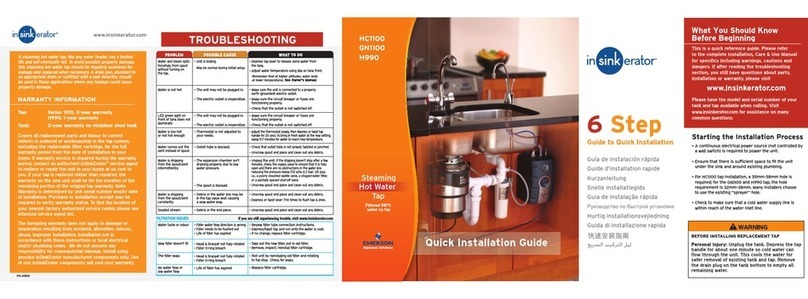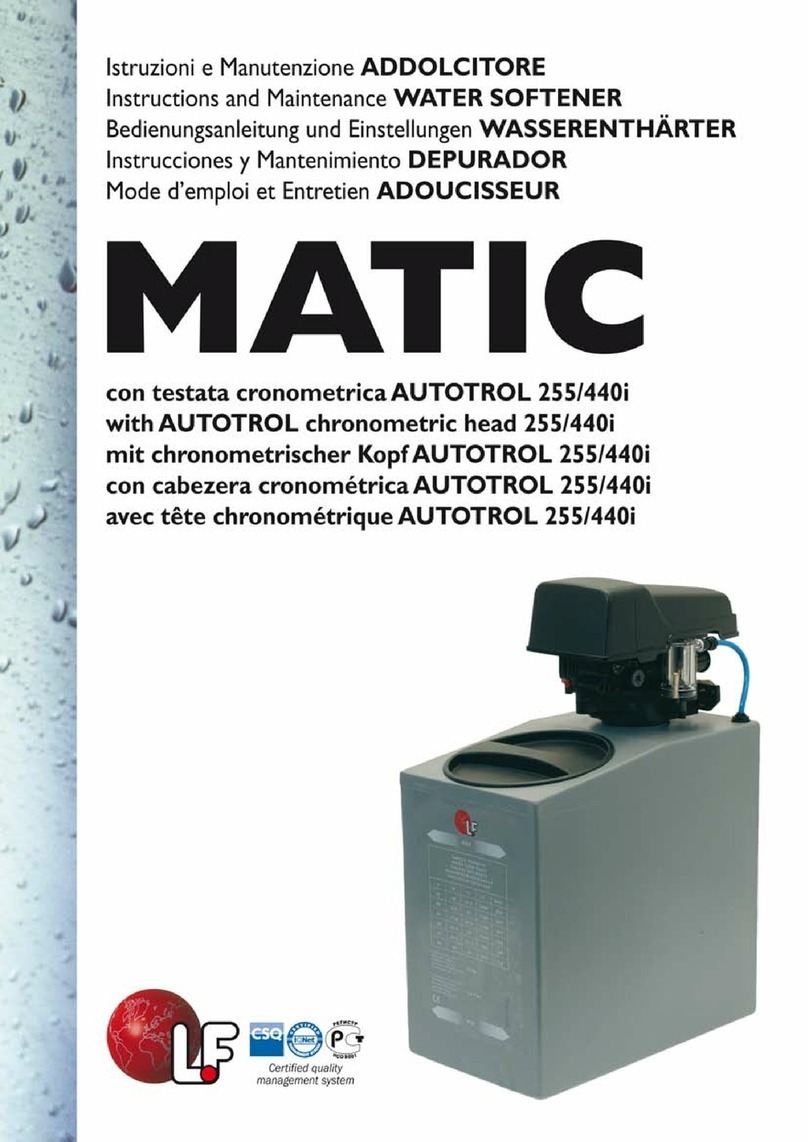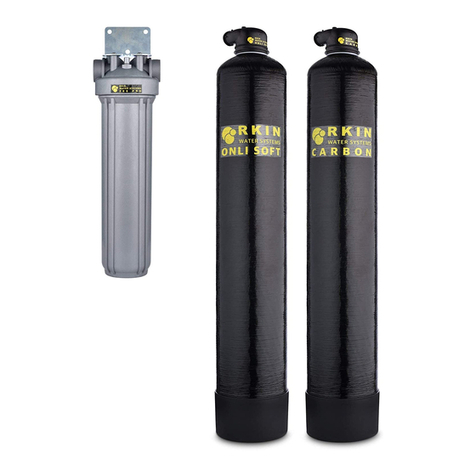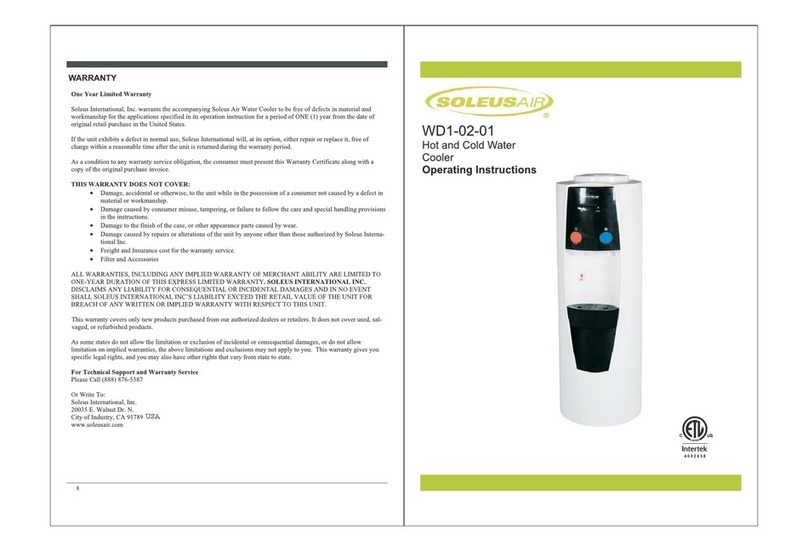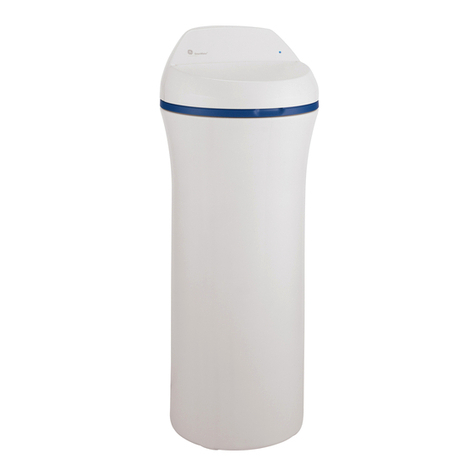elysator PUROTAP Compenso Series Parts list manual

www.elysator.com
Installation
Function
Operation
Service
Minerals and salts in sealed water circuits cause corrosion
and deposits.
PUROTAP filters the aggressive substances out of the fill
water to enable trouble-free operation.
Demineralised heating water
®
PUROTAP compenso
Reliability due to
desalinated water
for heating systems
to VDI 2035 and
SWKI BT 102-01
refill appliance
EN

Copyright 2012: ELYSATOR Engineering AG, Switzerland

www.elysator.com
9
8
10
11
12
7
5
6
4
5
4
Protection against limescale deposits
Compenso 12, replacing the resin, capacity
Function
Permanent connection
Operating the combined meter
Compenso 2, replacing the resin, capacity
Use with a heating system fill hose
Protection against corrosion
Compenso 25/50, replacing the resin, capacity
Technical specification
Service record
Contents
EN
Web version supercedes print version.
Updates may be made without notice.

0
3°
6°
11°
17°
20°
22°
25°
28°
14°
8°
100 g 200 g 300 g 400 g 500 g
5°
10°
20°
30°
35°
40°
45°
50°
25°
15°
°dH
°fH
The following table shows the amount of lime accumulating in a heating system
that is filled once with untreated water.
Fully desalinated water no longer contains any substances that can settle out or
be deposited in the boiler and heat exchanger.
VDI 2035, SWKI Directive BT102-01 and other European standards state that
water for filling heating systems should generally be demineralised for low salt
operation. Practical experience has shown that even at a low hardness level, mod-
ern appliances such as wall mounted gas boilers, heat pumps and solar thermal
systems can suffer damage from limescale deposits.
Compared to water that has been softened, demineralised water no longer con-
tains any salts. Its electrical conductivity is extremely low, allowing it to act as a
corrosion inhibitor.
Amount of dissolved calcium carbonate (CaCO )
3
Limescale deposits in the
boiler
Overheating, stress crack
Total hardness °fH
Total hardness °dH
3
Amount of lime in 1 m fill water
in the boiler and heat exchanger
Protection against limescale deposits
Pitting due to high salt content
Protection against corrosion
In line with applicable standards
Full desalination additionally removes all neutral salts such as chlorides,
sulphates and nitrates, which are known to cause corrosion above a certain
concentration and in certain combinations.
It has long been clear to experts in the field that fully desalinated water is ideal for
filling heating systems and that this will extend the service life of all components.
Today, this technology is so user friendly and affordable that it recommends itself
for practical application.
- VDI Guideline 2035
The process of full desalination (demineralisation) is therefore ideal for ensuring
that the water quality requirements of the following directives and standards are
met:
- SWKI BT 102-01
- DIN 50930
- ÖNORM 5195-1
Speed of corrosion
Salt content in the water
EN 4

The PUROTAP compenso filters lime and aggressive substances such as sulphates, nitrates and chlorides out of
the fill water. The appliance uses a mixed bed ion exchanger to provide demineralised, fully desalinated water
for any system size. This method does not emit any chemical additives into the water. The appliance operates
without an external power connection.
Function
2. Refilling the heating system
1. . Flushing the cartridge
Safety instructions
PUROTAP compenso should be pre-flushed
with approx. 10 l water before each use in
order to displace the initial flow water.
It is not permissible for a heating system fill
hose to remain permanently connected.
The refill appliance should never be left un-
attended whilst in use. Where DIN EN 1717
is applied (Germany), observe the regula-
tions regarding system separation.
After use, always close the freshwater tap,
the shut-off valve on the PUROTAP and the
boiler fill valve and remove the fill hose.
The ion exchange resin in the cartridge must
not enter the heating system. As a precau-
tion, a fine filter is fitted in the outlet which
must not be removed.
If the PURTOTAP compenso is occasionally used to refill the heating system via a fill hose, the cartridge should
be pre-flushed with fresh tap water in order to displace the initial flow water.
In doing so, it is important to check full desalination via the integral combined meter. When the system is then
filled, the fill hose must be first bled, in other words filled with water to prevent air entering the system via the
fill valve.
Use with a heating system fill hose 5
3. Close valves; remove hoses
5 EN

If a continuous top-up system will be
fitted, the installation must include all
the necessary safety equipment, such
as system separation, pressure moni-
tor and leak protection.
Safety instructions
Install PUROTAP compenso down-
stream of the top-up monitor.
PUROTAP compenso is pressure-tested to 6 bar and is therefore suitable for making a permanent connection
between the mains supply and the heating system.
Depending on national or local regulations, a direct connection may be subject to technical conditions which
must be observed. Where DIN EN 1717 is applied (Germany), also install a system separator upstream of the fill
appliance.
Permanent connection
Simplified permanent connection
Permanent connection in conjunction with automatic top-up
Keep valves closed when not in use
Mains
System separator
Automatic
top-up monitor
Safety instructions
The regulations of the water utility
must be observed when connecting
directly to the mains supply (e.g. sys-
tem separator to DIN EN 1717).
After use, valves to the heating sys-
tem and mains supply must be
closed.
Mains
EN 6

3 x AAA
Recommended limit:
33 TDS/50 µS; above this
the resin will need to be
replaced
7 EN
Set limit for
warning
Limit
Reset
meter
Flow rate
ON/OFF
Total litres treated
Select either
TDS/µS
Automatic quality monitor
Display:
Keys:
Limit warning signal
Operating the combined meter
Changing the batteries
The combined meter is battery-operated. It measures the flow rate in l/min, the total volume in litres and
the concentration of dissolved minerals, either in microsiemens or TDS. In addition, a limit can be set for the
maximum concentration of minerals tolerated in the demineralised water (appliance outlet). The limit and
overall total can both be reset.
Change the batteries when the battery warning symbol
appears or the display is faint or blank. Undo the 4 screws
on the front and carefully open the device. Change the bat-
teries. 3 x AAA.
Each time you touch this key, the boundary value is raised by 6/7 TDS or by 10 µS/cm. Holding down the key
for 3 seconds resets the boundary value to zero. Programming the boundary value serves as a warning as to
when the ion exchanger resin is exhausted.
This key can be used to switch at any time between the TDS unit of measurement (Total Dissolved Solids)
and electrical conductivity. Both are used to measure the concentration of dissolved minerals in the water.
Most European component manufacturers use the µS/cm unit of measurement (microsiemens).
1 °fH equals approx. 20 µS/cm; 1 °dH equals approx. 35 µS/cm.
The water hardness at the outlet of the refill appliance can be calculated using the following rule of thumb:
1
2
Auto mode: If the ON key is pressed for a second time, the combined meter begins automatic monitoring.
The eye symbol appears to indicate that monitoring has been enabled. In auto mode, the meter only takes
measurements when water is actually passing over it. If the water draw-off is interrupted, the meter conti-
nues to show the last captured value. While water is being drawn off, the combined meter measures the
water quality every 40 litres. If the limit is exceeded in two successive measurements, the display conti-
nuously flashes red. This indicates that the ion exchange resin is spent and needs replacing. If the ON key is
pressed for a third time, the meter exits auto mode.
If the ON key is pressed once, the water quality is measured for 10 seconds and compared to the set limit.
The measured value is shown. If it is above the limit, the LED glows red; if it is below, the LED glows green
while the measurement is being taken. If required, the measurement can be repeated manually.
3
Pressing the reset key for 3 seconds resets the overall total on the meter. This is recommended every time
the resin is replaced, as it gives a reference point for the remaining capacity of the ion exchange resin.
4

°fH
5°
10°
20°
30°
35°
40°
45°
50°
25°
15°
0 l
50 l
1'00 l
150 l
200 l
250 l
300 l
350 l
400 l
450 l
500 l
°dH
3°
6°
11°
17°
20°
22°
25°
28°
14°
8°
PUROTAP compenso 2
Dispose of spent resin
with household waste;
refill with new resin
2.
Resin
Unscrew the
container;
reset the com-
bined meter
(see instruc-
tions)
3.
Close the ball valves; undo
the container
1.
Household
waste
Capacity of the ion exchanger
For example: If the water hardness is
12.5 °dH, the capacity of the resin will
be exactly 200 l of demineralised
water.
The capacity of the ion exchange resin
depends on the water hardness. The
capacity can be read off the adjacent
table or calculated using the capacity
figure given for the quantity of resin.
The PUROTAP compenso 2 resin filling
has a capacity of 4500 l @ 1 °fH or
2500 l @ 1 °dH.
If using the German hardness scale,
take the number 2500 and divide this
by the water hardness in °dH. If using
the French hardness scale, take the
number 4500 and divide this by the
water hardness in °fH. The result is
the capacity of the resin in litres of
water.
Capacity
Replacing the resin
4'500 l à 1°fH 2'500 l à 1 °dH
Litres of demineralised (fully desalinated) water per cartridge
EN 8

0 l
500 l
1'000 l
1'500 l
2'000 l
2’500 l
3’000 l
3'500 l
4’000 l
4’500 l
5’000 l
°fH °dH
5°
10°
20°
30°
35°
40°
45°
50°
25°
15°
3°
6°
11°
17°
20°
22°
25°
28°
14°
8°
PUROTAP compenso 12
Replacing the resin
Close ball valve in the outlet, con-
nect a hose at the drain valve and
route into the supplied collection
sack; flush out the resin at mains
pressure
Undo wire armoured hoses;
undo head section
Fill with new resin, mount
head section, connect wire
armoured hoses, reset com-
bined meter (see instructions)
1.
2.
3.
Household
waste
Resin
Capacity of the ion exchanger
The capacity of the ion exchange resin
depends on the water hardness. The
capacity can be read off the adjacent
table or calculated using the capacity
figure given for the quantity of resin.
The PUROTAP compenso 12 resin fill-
3
ing has a capacity of 35 m @ 1 °fH or
3
20 m @ 1 °dH.
The result is the capacity of the resin
in cubic metres of water.
If using the German hardness scale,
take the number 20 and divide this by
the water hardness in °dH. If using the
French hardness scale, take the num-
ber 35 and divide this by the water
hardness in °fH.
For example: If the water hardness is
20 °dH, the capacity of the resin will
3
be exactly 1 m (1000 l) of deminera-
lised water.
3
35 m à 1°fH 3
20 m à 1 °dH
Capacity
Litres of demineralised (fully desalinated) water per cartridge
9 EN

0 l
750 l
1’500 l
2’250 l
3’000 l
3’750 l
4’500 l
5’250 l
6’000 l
6’750 l
7’500 l
8’250 l
9’000 l
9’750 l
10’500 l
11’250 l
12’000 l
12’750 l
13’500 l
14’250 l
15’000 l
°fH
°dH
5°
10°
20°
30°
35°
40°
45°
50°
25°
15°
3°
6°
11°
17°
20°
22°
25°
28°
14°
8°
0 l
500 l
1’000 l
1’500 l
2’000 l
2’500 l
3’000 l
3’500 l
4’000 l
4’500 l
5’000 l
5’500 l
6’000 l
6’500 l
7’000 l
7’500 l
8’000 l
8’500 l
9’000 l
9’500 l
10’000 l
°fH °dH
5°
10°
20°
30°
35°
40°
45°
50°
25°
15°
3°
6°
11°
17°
20°
22°
25°
28°
14°
8°
PUROTAP compenso 25 capacity
PUROTAP compenso 50 capacity
Total hardness
Total hardness
Total hardness
Total hardness
For example: If the water hardness is
20 °dH, the capacity of the PUROTAP
compenso 25 resin will be exactly
2000 l of demineralised water. (Ca-
3
pacity figure of 40 m divided by hard-
3
ness 20 °dH = 2 m = 2000 l.)
To calculate the capacity, divide the
capacity figure for the PUROTAP
compenso by the water hardness indi-
cated.
The capacity of the ion exchange resin
depends on the water hardness. The
capacity can be read off the adjacent
table or calculated using the capacity
figure given for the quantity of resin.
The PUROTAP compenso 25 resin fill-
3
ing has a capacity of 70 m of 1 °fH, or
3
40 m of 1 °dH. For the compenso 50
the figures are doubled.
1. Close ball valve in the outlet, con-
nect a hose at the drain valve and
route into the supplied collection
sack; flush out the resin at mains
pressure
Fill with new resin, mount
head section, connect wire
armoured hoses, reset com-
bined meter (see instruc-
tions)
3.
Undo wire armoured hoses;
undo head section
Household
waste
Resin
PUROTAP compenso 25/50
Replacing the resin
2.
3 3
140 m à 1°fH 80 m à 1 °dH
3 3
70 m à 1°fH 40 m à 1 °dH
Capacity of the
ion exchanger
EN 10
Litres of demineralised (fully desalinated)
water per cartr.
Litres of demineralised (fully desalinated)
water per cartr.

PUROTAP compenso 2 compenso 12 compenso 25 compenso 50
< 250 l < 2'500 l < 5'000 l < 10'000 l
3
2.5 m 3
20 m 3
40 m 3
80 m
3
4.5 m 3
35 m 3
70 m 3
140 m
2,5 l/min 10 l/min 20 l/min 20 l/min
< 6 bar < 6 bar < 6 bar < 6 bar
60 °C 60 °C 60 °C 60 °C
45 cm 80 cm 80 cm 80 cm
46 cm 70 cm 115 cm 142 cm
5 kg 7.5 kg 15 kg 18 kg
1,75 l 12.5 l 25 l 50 l
PUROTAP compenso
Technical specification
Direction of flow
compenso 12
compenso 2
compenso 25/50
Standard delivery as depicted
Description:
Integral combined meter for measuring flow rate, total
volume, water quality and for limit control. Battery operated
with automatic switch-on function.
PUROTAP compenso, refill appliance for the production of fully
desalinated heating water to the latest guidelines (VDI 2035
and SWKI BT 102-01), based on ion exchange. Resin vessel in
stainless steel with floor or wall mounting bracket. Head
section with integral shut-off valves and air vent valve. Resin
can be easily replaced by the user on site.
Suitable for permanent connection in conjunction with
specific regulations and engineering guidelines (e.g. DIN EN
1717).
Direction of flow
Annual demand
Capacity at 1 °dH
Capacity at 1 °fH
Delivery capacity
Operating pressure
Tmax. temp.
Installed length
Height
Empty weight
Resin filling
11 EN

E919
Service record
Date
Installer: Property
Product installed
Resin changed
litres
Combined meter Company
Mains water hardness
Calculated capacity
°fH / ° dH / TDS
EN 12
This manual suits for next models
4
Table of contents
Popular Water Dispenser manuals by other brands
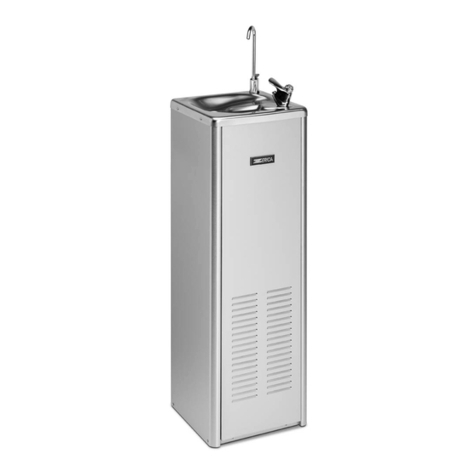
Zerica
Zerica REFRESH P HPDC Installation and operation manual

Whirlpool
Whirlpool Hot water dispenser Installation instructions and use and care guide

BRIO
BRIO CLCTPOU620UVF2 instruction manual

Messner
Messner Skimmer 140 operating instructions

Elkay
Elkay EZO8WS 1A Series Installation & use manual
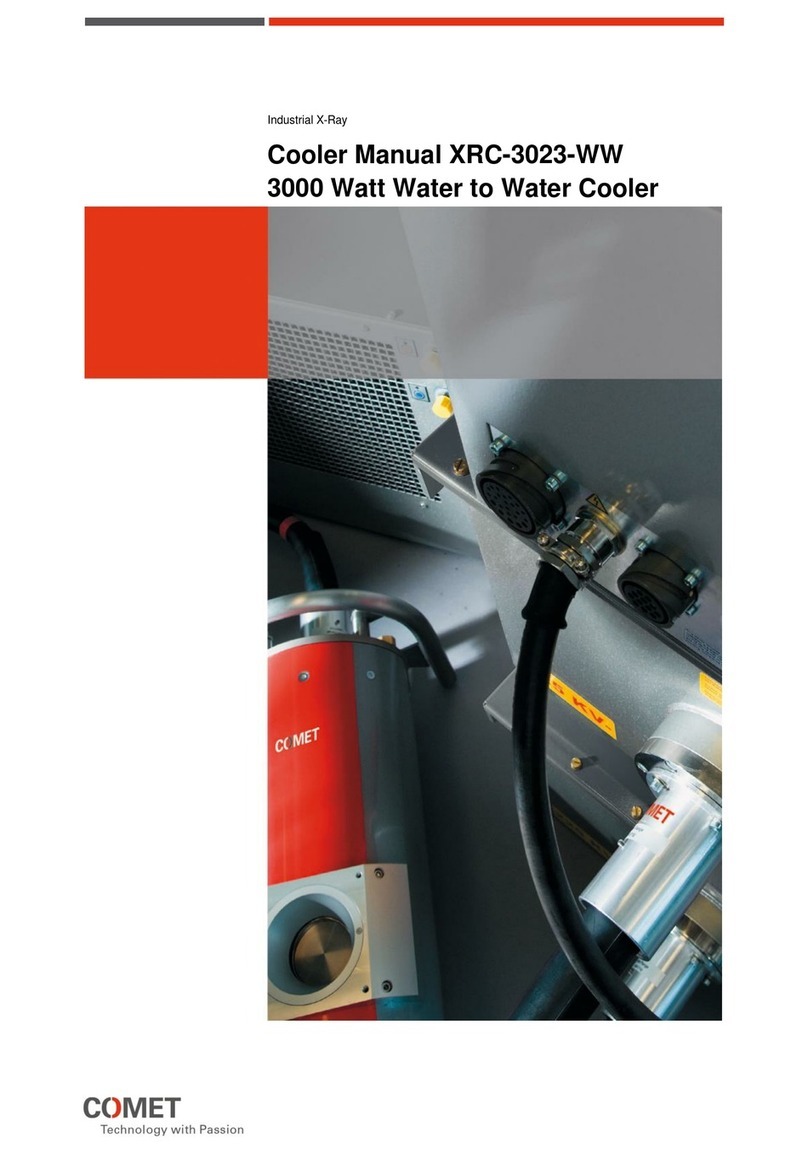
Comet
Comet XRC-3023-WW manual




